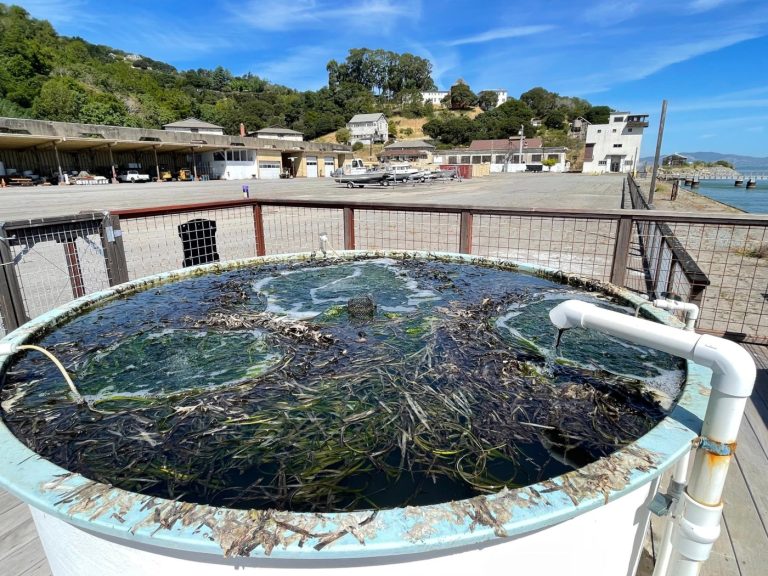Gov. Gavin Newsom signed legislation Monday aimed at easing spikes in California’s already high gasoline prices, a key consumer protection that he’d sought from a special legislative session.
Whether Newsom’s proposed reserve requirement for the state’s gas refineries, cheered by consumer advocates, will keep fuel prices in check remains to be seen — the fuel industry, labor unions, Republicans and governors of two neighboring states say that it could create shortages and higher prices.
But an increase of nearly 50 cents a gallon may be on the way next year, anyway, courtesy of a state climate program that has enjoyed popular and bipartisan support. It’s awkward timing for Newsom and state Democrats, who are taking a victory lap after a splashy campaign to cut prices at the pump with the refinery reserve requirement.
California Gov. Gavin Newsom speaks as he signs legislation at the state Capitol on Monday, Oct. 14, 2024, aimed at preventing gas prices from spiking at the pump. (AP Photo/Sophie Austin)
California’s average $4.67 a gallon gas price already is the highest in the U.S., well above the $3.20 national average. It’s critical to Newsom, and lawmakers running for reelection, to make progress on stubborn gas prices in California, said Thad Kousser, a professor of political science at UC San Diego.
“Having something to deliver for the election was paramount for the Democratic caucus,” he said.
With a national presidential election looming and a spotlight on the Democratic nominee, Vice President Kamala Harris of California, the Democratic governor and legislative majority aren’t looking to give voters more reasons to fear higher prices as they seek to hold the White House and expand their control of Congress.
On Nov. 8, just days after the election, the California Air Resources Board will consider lowering its carbon intensity standard for fuel, which would increase prices. Alongside electric vehicle mandates, the fuel standard is a key part of California’s strategy to become carbon neutral by 2045, no longer adding to the amount of atmospheric “greenhouse gases” that cause rising global temperatures.
Currently, the fuel standard adds about 8 cents per gallon of gas, by one estimate. The price of gas is made up of many factors. According to the California Energy Commission, the biggest chunk is the price of crude oil, which accounted for about $1.90 as of Oct. 7. Refining, marketing and distribution added about $1.10. Taxes added 88 cents, and all environmental programs, including the low-carbon fuel standard, added 53 cents.
Vehicles charge in a parking lot at the Warm Springs BART Station on Thursday, Aug. 29. 2024, in Fremont, Calif. BART is getting more than $14 million from the federal government to install EV charging stations at all the parking lots in the system. (Aric Crabb/Bay Area News Group)
Related Articles
Gov. Newsom signs bill he says will help avoid gas price spikes
California Assembly passes measure aimed at easing gas price spikes
Skinner: Gasoline reserves can save us all money at the pump
Gov. Newsom signs new laws cracking down on oil industry in California
Gov. Newsom’s gas price proposal debated at special session legislative hearings
The standard sets limits on the carbon content of fuels such as gasoline and diesel. Over time, those limits increase. Crude oil refineries and other polluters that can’t comply with the carbon limits pay a tax by buying “credits” from those making cleaner fuels. That subsidizes the development of cleaner fuels like renewable diesel, which is made from vegetable oil.
Since 2011, the fuel standard has funneled more than $22 billion in private investment in alternative fuels and clean energy projects. That’s blunting the climate impact of California’s transportation sector, its largest source of greenhouse gases.
But the Air Resources Board, which is appointed by Newsom and lawmakers, is considering lowering the carbon standard because a wave of renewable diesel investment has produced a glut of credits, which drives down incentives for clean fuel innovators, said Dave Hackett, an energy policy consultant with Stillwater Associates.
Last year, the board estimated that the proposed lower standard could drive a 47-cent price increase in 2025 that could reach 79 cents in 2035. The board later disavowed those figures but hasn’t released another estimate, according to the Los Angeles Times. A spokesperson for the board did not respond to a request for comment. If passed, the amendments also would reduce asthma symptoms for more than 70,000 Californians, according to the board’s estimate.
Aaron Smith, a professor of agricultural economics at UC Davis who has studied the fuel standard, estimates price increases from 20 cents to 84 cents per gallon in 2030 if the board approves the amendments. If it rejects them, the regulations could still add as much as 53 cents per gallon by then, Smith said.
Although that would pose a challenge to drivers, Smith said the low-carbon fuel standard is an important part of California’s climate strategy. Scientists say climate change is already intensifying natural disasters in California and nationally while driving terrifying declines in biodiversity, and maintain it poses an existential threat to humanity over the century.
“Yes, it’s worth it to have a tax on petroleum, or fossil fuel emissions generally,” he said.
The new law signed Monday allows the California Energy Commission to regulate the amount of fuel stored by refiners and to prevent maintenance on refineries when supply is low. The idea is to prevent supply shortages that contribute to price spikes, like those seen in September 2022 when gas reached $7 per gallon.
The California Energy Commission estimated that the bill could have cut $2 billion from the $7 billion that Californians paid for gas last year, at most.
But if the law does help alleviate gas prices, it’s unlikely to make a big dent, said Severin Borenstein, a professor of business administration and public policy at UC Berkeley who has served on state energy advisory boards since the 1990s.
“It is really clear that this isn’t going to address most of the problem,” Borenstein said. “Our prices are higher than the rest of the country more than the difference in taxes and environmental cost.”












